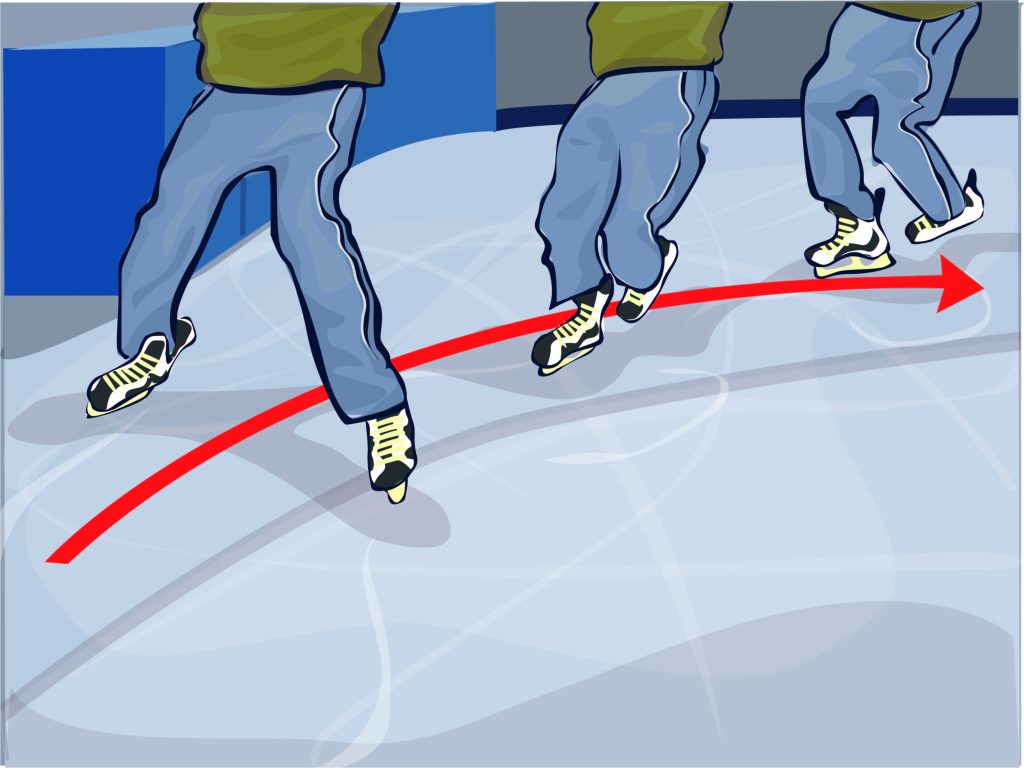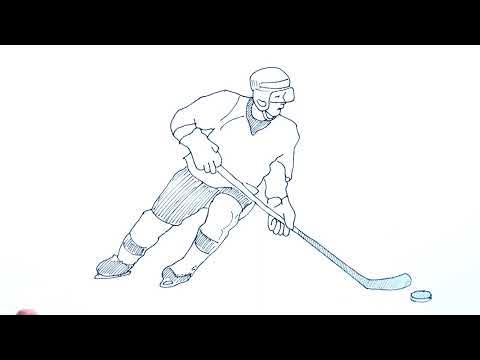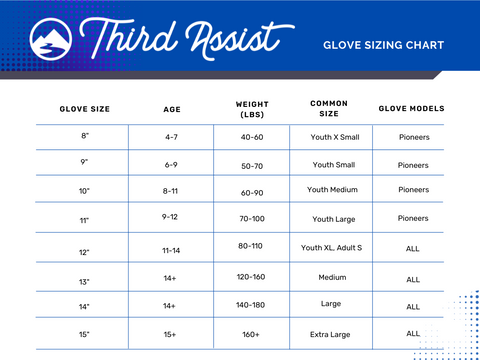Want to learn how to ice skate backwards for hockey? It’s easier than you think.
Skating backward is a skill every hockey player needs. Ice skating backward improves your game. It helps with defense and quick turns. New to ice skating? Don’t worry. With practice, you can do it. Start with small steps. Gain confidence on the ice.
Soon, you’ll skate backward like a pro. In this guide, we’ll show you steps to master this skill. Ready to improve your hockey skills? Let’s get started.
Introduction To Backwards Hockey Skating
Learning how to ice skate backwards for hockey is essential for players. It improves agility, balance, and defensive skills. Start with basic drills and practice regularly to gain confidence.
Backwards skating in hockey is essential. It allows players to defend and transition smoothly. Mastering this skill improves overall performance. It also boosts confidence on the ice. To start, focus on balance and body position. Keep your knees bent and your weight centered. Your head should be up, looking forward. Practice gliding backwards slowly. Gradually increase your speed as you gain control.Importance Of Backwards Skating
Backwards skating is crucial for defense. It enables players to keep up with opposing forwards. Good backwards skating helps maintain proper defensive positioning. It also aids in quick transitions. This helps players switch from defense to offense rapidly. Good backwards skating can set you apart from others. It is a key skill for hockey success.Benefits For Hockey Players
Backwards skating offers many benefits. It enhances agility and balance. Players can move confidently in all directions. It also improves overall skating skills. Players who skate well backwards often excel in other areas too. This skill boosts game awareness. Players can better anticipate plays and react quickly. Backwards skating also builds strength and endurance. It works different muscle groups, improving overall fitness. Practicing this skill can lead to fewer injuries. Players develop better control and stability on the ice. “`Essential Equipment
Learning how to ice skate backwards in hockey involves more than just practice. Having the right gear is essential for performance and safety. This section covers the crucial equipment you need.
Choosing The Right Skates
Your skates are the foundation of your performance. Ensure they fit snugly but comfortably. A good fit provides better control on the ice. Here are key points to consider:
- Size: Your toes should barely touch the front of the skate.
- Support: Look for skates with good ankle support.
- Blades: Sharpen your blades regularly for better grip.
Proper skates make backward skating easier and safer.
Protective Gear
Protective gear is vital to prevent injuries while you practice. Hockey can be rough, so gear up properly. Here is a list of essential protective items:
- Helmet: Protects your head from falls and collisions.
- Mouthguard: Shields your teeth and gums.
- Gloves: Protects your hands and provides better grip on the stick.
- Shin Guards: Shields your lower legs from pucks and sticks.
- Elbow Pads: Guards your elbows during falls.
- Shoulder Pads: Protects your shoulders and upper body.
Wearing the right protective gear reduces the risk of serious injuries and boosts your confidence on the ice.
Basic Techniques
Learning to ice skate backwards in hockey can be a thrilling experience. It enhances your agility and gives you an edge on the ice. But mastering this skill requires understanding the basic techniques. Here, we will break down the fundamentals to help you get started.
Proper Body Position
Keep your knees slightly bent. This lowers your center of gravity and helps maintain balance. Your back should be straight, not hunched. This position allows for better control.
Hold your head up and look over your shoulder. This ensures you see where you are going. Don’t look down at your feet. Trust your muscle memory to guide your movements.
Weight Distribution
Distribute your weight evenly on both skates. Avoid leaning too much on one side. This prevents wobbling and keeps you stable.
Shift your weight from one foot to the other as you push off. This action propels you backwards. Practice shifting your weight smoothly to gain speed and maintain control.

Credit: www.wikihow.com
Initial Practice Drills
Learning to ice skate backwards in hockey is challenging. It requires balance, coordination, and practice. Start with basic drills to build confidence and skill. These drills will help you get comfortable on the ice. They are fundamental for any hockey player.
Gliding Backwards
Begin with gliding backwards. This is a simple, yet crucial drill. Follow these steps:
- Stand with your feet shoulder-width apart.
- Bend your knees slightly.
- Push off gently with one foot.
- Glide backwards on the other foot.
- Switch feet and repeat.
Practice this drill regularly. It will improve your balance and control. Remember to keep your head up and eyes forward. This helps maintain awareness of your surroundings.
Crossovers
Crossovers are advanced drills. They increase speed and agility. Here is how to perform crossovers:
- Start gliding backwards.
- Cross one foot over the other.
- Push off with the outside edge of the back foot.
- Bring the back foot around and start again.
Repeat these steps in a continuous motion. Practice makes perfect. Crossovers help you change direction quickly. They are essential for defensive maneuvers in hockey.
| Drill | Focus | Frequency |
|---|---|---|
| Gliding Backwards | Balance and Control | Daily |
| Crossovers | Speed and Agility | Every Other Day |
Advanced Maneuvers
Learning to ice skate backwards in hockey is a challenging but rewarding skill. Once you have mastered the basics, it’s time to explore advanced maneuvers. These techniques will enhance your agility and control on the ice. In this section, we’ll delve into two key areas: Transitioning from Forward to Backward and Backward Speed Control.
Transitioning From Forward To Backward
Transitioning smoothly from forward to backward skating is crucial in hockey. Here are the steps to follow:
- Shift your weight to the balls of your feet.
- Turn your hips to face the direction you want to go.
- Use your shoulders to guide the turn.
- Move one foot backward while the other foot follows.
- Bend your knees to maintain balance and control.
Practice these steps slowly at first. Increase your speed as you become more comfortable.
Backward Speed Control
Controlling your speed while skating backwards is essential for effective gameplay. Here are some tips:
- Keep your knees bent to stay balanced.
- Use your edges to manage speed.
- Push off with the inner edge of one skate.
- Glide on the outer edge of the opposite skate.
- Practice stops by using a T-stop or snowplow technique.
It’s important to practice these techniques regularly. Consistency will improve your backward skating skills.
| Technique | Description |
|---|---|
| Weight Shift | Shift your weight to the balls of your feet. |
| Hip Turn | Turn your hips to face your desired direction. |
| Shoulder Guide | Use your shoulders to guide the turn. |
| Knee Bend | Bend your knees for balance and control. |
| Edge Use | Use your edges to manage speed. |

Credit: m.youtube.com
Common Mistakes
Learning to ice skate backwards in hockey can be challenging. Many beginners make common mistakes that hinder their progress. Identifying these errors helps improve technique and enhances overall performance. Below, we discuss some typical errors skaters make.
Incorrect Posture
Incorrect posture is a frequent mistake. Many skaters stand too upright. This position makes it hard to balance and move efficiently. Instead, bend your knees slightly. Keep your back straight and your head up. This stance helps maintain balance and control. It also allows for better agility on the ice.
Poor Balance
Poor balance is another common problem. Many skaters put too much weight on their heels. This makes it difficult to glide smoothly. Distribute your weight evenly across both feet. Lean slightly forward to maintain balance. Practice shifting your weight from one foot to the other. This helps build the necessary muscle memory for smooth backward skating.
Training Tips
Learning to ice skate backwards in hockey can seem challenging at first. With the right training tips, you can master this skill. Here, we share some essential training tips to help you skate backwards with confidence.
Consistent Practice
Consistency is key in developing any new skill. Spend time on the ice regularly. Practice your backwards skating every session. Start with short sessions. Gradually increase your practice time. Focus on your balance. Try to maintain a low center of gravity. This helps with stability. Keep your knees slightly bent. Push off with the balls of your feet.
Practice your stride. Take short, quick steps. This helps you gain speed. Remember to look over your shoulder. This allows you to see where you are going. It also helps with balance. The more you practice, the better you will get.
Seeking Professional Coaching
Professional coaching can make a big difference. A coach can provide personalized feedback. They can help identify areas for improvement. A coach can also teach proper techniques. This ensures you are practicing correctly. Coaches have experience. They know what works. They can help you progress faster. Seek out a coach with hockey experience.
Join a skating clinic. These often offer specialized training. Clinics provide an opportunity to learn from different coaches. They also offer a chance to practice with peers. Learning in a group can be motivating. It can also be fun.
Safety Measures
Ice skating backwards in hockey can be thrilling. But, it’s essential to follow safety measures to avoid injuries. Proper preparation and attention to safety can make this activity fun and safe.
Warming Up Properly
Warming up is crucial. A good warm-up prepares your body for action.
- Start with light jogging to increase your heart rate.
- Do some dynamic stretches like arm circles and leg swings.
- Focus on stretching your legs and lower back.
- Spend at least 10 minutes on your warm-up routine.
Avoiding Injuries
Injuries can spoil the fun. So, take steps to stay safe.
- Wear a helmet to protect your head.
- Use knee and elbow pads for added protection.
- Check your skates for proper fit and sharpness.
- Skate in a clear, obstacle-free area.
- Practice falling safely to reduce injury risk.
By following these safety measures, you can enjoy ice skating backwards in hockey with confidence.
Applying Skills In Game Situations
Skating backwards is crucial in hockey. It’s essential for both defense and offense. Mastering this skill can change your game. Let’s explore how to use these skills effectively.
Defensive Strategies
Strong defense relies on backward skating. It helps you keep up with attackers. Always face the opponent. This way, you see their moves and react quickly.
- Gap Control: Maintain a short distance from the attacker.
- Stick Positioning: Keep your stick on the ice to block passes.
- Body Positioning: Stay between the attacker and the goal.
Practicing these moves helps in game situations. It improves your team’s defense.
Offensive Techniques
Backward skating isn’t just for defense. It can boost your offense too. This technique can surprise opponents and create scoring chances.
| Technique | Benefit |
|---|---|
| Quick Pivots: | Change direction fast to confuse defenders. |
| Passing: | Skate backward while looking for open teammates. |
| Shooting: | Shoot while moving backward to catch goalies off guard. |
Use these techniques to keep the pressure on the other team. They can lead to more goals and more wins.

Credit: www.youtube.com
Frequently Asked Questions
How Do You Start Skating Backwards?
To start skating backwards, begin by bending your knees slightly. Push off with one foot while gliding on the other. Practice shifting your weight and using small, controlled pushes to maintain balance and momentum.
What Are Common Mistakes In Backward Skating?
Common mistakes include leaning too far forward, not bending your knees enough, and pushing too hard. These can cause loss of balance. Focus on smooth, controlled movements and proper posture to avoid these errors.
How Can I Improve My Backward Skating Speed?
To improve backward skating speed, work on your leg strength and balance. Practice quick, powerful pushes and maintaining a low, stable stance. Consistent practice will help you gain speed and confidence.
Is Backward Skating Important For Hockey?
Yes, backward skating is crucial for hockey. It allows players to maintain defensive positions and transition quickly between offense and defense. Mastering this skill enhances overall game performance and effectiveness on the ice.
Conclusion
Learning to ice skate backwards for hockey takes practice and patience. Keep your knees bent. Stay balanced. Remember to push off with your toes. Practice often to improve your skills. Soon, you will feel more confident skating backwards. Enjoy the progress you make on the ice.
Happy skating!



